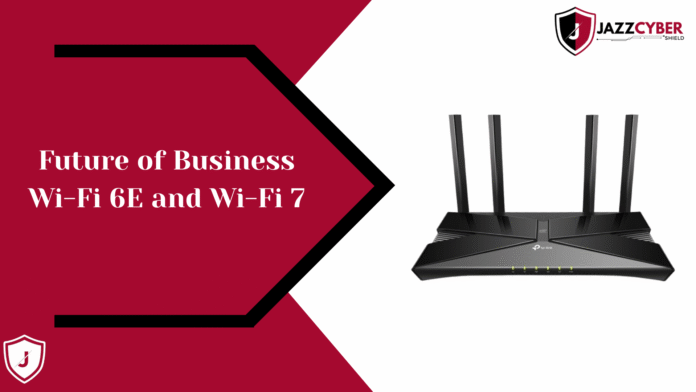Commercial Wi-Fi is changing fast. With Wi-Fi 6E and Wi-Fi 7, workplaces gain faster speeds, stronger security, and smoother connectivity. Business today demands stable networks for audio and video calls, unique cloud apps, and external collaboration. Thus, the future of business Wi-Fi looks brighter, faster, and a lot more reliable.
Why Wi-Fi 6E Matters for Businesses

Wi-Fi 6E opens up the 6GHz band. It reduces possible congestion, increases the possible capacity, and decreases the likelihood of interference when an office attempts to make simultaneous connections with several devices. The combined benefit could mean simply a stronger tie with multiple devices connecting at once for their business. In addition, Wi-Fi 6E supports high-bandwidth applications, including video conferencing and real-time collaboration.
Wi-Fi 6E combines WPA3, thus making security even better. In addition, IT teams are able to manage network systems in larger offices very easily. Lastly, these organizations save costs incurred due to assisting small and medium offices with greater coverage instead of requiring extra access points.
How Wi-Fi 7 Transforms Workplaces
Wi-Fi 7 pushes wireless further. It has ultra-low latencies, multi-gigabit speeds, and promises to maintain excellent performance. In doing so, it becomes suitable for app-driven-AI, AR/VR training, and intelligent office systems. Most importantly, Wi-Fi 7 will prepare the workspace for every digital future requirement to be covered.
In addition, it introduces Multi-Link Operation (MLO), which allows devices to connect at the same time on multiple bands, so that users would have a seamless performance free of interruptions. In addition, businesses achieve much load balancing, keeping their networks very stable even under very heavy traffic usage.
Wi-Fi 6E versus Wi-Fi 7 in Offices
While both Wi-Fi 6E and Wi-Fi 7 enhance networking in an office environment, one particular country may benefit from buying the first one. This is in view of companies that cannot afford to wait in long queues for the latest advances when they are necessary for reliable but highly beneficial upgrades in office connectivity. In contrast, Wi-Fi 7 would be a plausible option for enterprises that wish to prepare for today’s advanced applications such as 8K streaming and cloud AI. Just to widen the perspective, businesses will choose on the basis of what service is right for them at present and what is anticipated in the future.
Wi-Fi 6E is again geared towards being a low-cost answer for small to medium offices. On the contrary, Wi-Fi 7 would then dominate the larger types of organizations that desire an extreme speed and capacity. Therefore, IT leaders have to weigh all these factors before making the upgrade.
Timelines of Business Network Resilience
Workplaces will need to accommodate increased data usage, smart devices, and hybrid work models, making a step forward for Wi-Fi 6E with regard to Wi-Fi 7 performance. These technologies endeavor together toward highly secure, scalable, and superfast connectivity in a work environment.
It’s all out there for the early adopters to grab and gain a competitive advantage over the others. Strong and steady Wi-Fi lends itself to productivity, cloud computing, and cybersecurity. Thus, Wi-Fi 6E and Wi-Fi 7 are to rule business Wi-Fi in the upcoming years.




It’s interesting how Wi-Fi 6E and Wi-Fi 7 aren’t just about faster speeds but also about handling the growing number of connected devices in modern workplaces. As more businesses rely on video conferencing and cloud-based tools, the reduced latency and improved reliability could make a huge difference in day-to-day operations. I’m curious to see how quickly organizations will adopt these upgrades given the increasing demand for seamless connectivity.
Blog comment creationGreat breakdown of how Wi-Fi 6E and Wi-Fi 7 will shape workplace connectivity. One interesting angle is how these upgrades could impact hybrid work—fewer dropped calls and smoother collaboration tools could really change the employee experience. It’ll be exciting to see how businesses balance the promise of faster speeds with the need for consistent security policies as adoption grows.
Great overview of how WiBlog comment creation-Fi 6E and Wi-Fi 7 are reshaping workplace connectivity. One interesting angle is how these upgrades won’t just improve speed, but also reduce network congestion in offices with a growing number of IoT devices. It’ll be exciting to see how businesses balance the investment in new infrastructure with the demand for seamless, always-on connectivity.
Blog comment creationGreat breakdown of how Wi-Fi 6E and Wi-Fi 7 are shaping workplace connectivity. One interesting angle is how these upgrades could support the growing number of IoT devices in offices, since low latency and higher capacity will be critical as businesses scale. It’ll be exciting to see how IT teams balance the promise of these standards with the security challenges that come along with wider adoption.